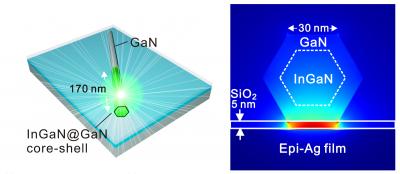Scientists at The University of Texas at Austin claim to have created the smallest semiconductor laser in the world. The university’s physicists partnered with colleagues in China and Taiwan to achieve this novel breakthrough.
 This is an illustration of the nanoscale semiconductor structure used for demonstrating the ultra-low-threshold nanolaser. A single nanorod is placed on a thin silver film (28 nm thick). The resonant electromagnetic field is concentrated at the 5-nm-thick silicon dioxide gap layer sandwiched by the semiconductor nanorod and the atomically smooth silver film.
This is an illustration of the nanoscale semiconductor structure used for demonstrating the ultra-low-threshold nanolaser. A single nanorod is placed on a thin silver film (28 nm thick). The resonant electromagnetic field is concentrated at the 5-nm-thick silicon dioxide gap layer sandwiched by the semiconductor nanorod and the atomically smooth silver film.
Reducing the size of semiconductor lasers is critical for developing smaller and quicker photon-based technologies that require low energy. Miniaturization is important for many applications including advanced communication technologies, ultrafast computer chips and development of sensitive biosensors for medical research and disease treatment.
Nanolasers can be used for generating optical signals and could one day be used instead of electronic circuits. However, the 3-D optical diffraction limit has curtailed the performance and size of photonic devices.
The newly developed nanolaser device operates below the 3-D diffraction limit. When operated, a green light that is invisible to the naked eye is emitted. A gallium nitride nanorod which is filled with indium gallium nitride partially, is used in the construction of the device. A thin silicon insulating layer covers a silver film layer, and the gallium nitride nanorod is placed over it.
The silver film used is atomically smooth which is important for constructing photonic devices that do not scatter plasmons. Plasmonic structures are important for reducing loss of data.
These nanolasers can be used for "on-chip" communication systems where it will help in reducing data loss.
The study has been published in the journal Science.